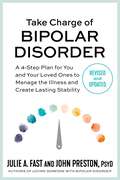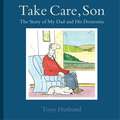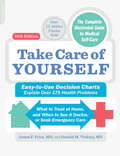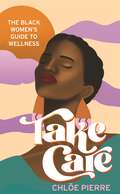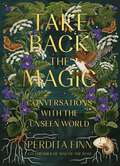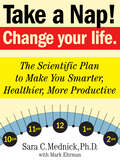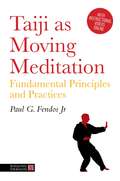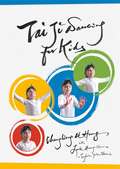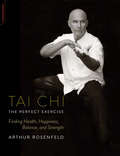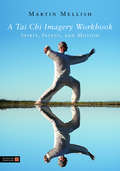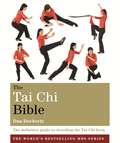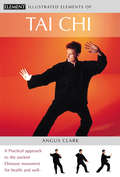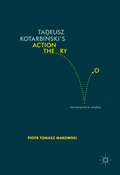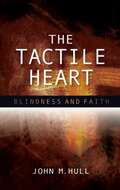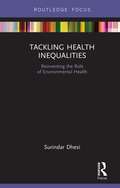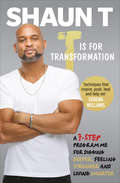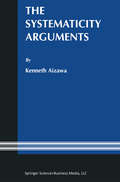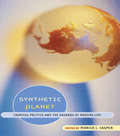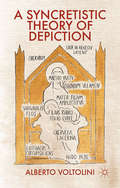- Table View
- List View
Take Charge of Bipolar Disorder: A 4-Step Plan for You and Your Loved Ones to Manage the Illness and Create Lasting Stability
by John Preston Julie A. FastThe authors offer those with Bipolar Disorder a four-step plan towards managing the illness and creating lasting stability.
Take Care, Son: The Story of My Dad and his Dementia
by Tony HusbandHi Dad . . . can we have a chat about your dementia . . . Can you remember how it started?When Ron Husband started to forget things - dates, names, appointments . . . daft things, important things - it took a while to realise that this was 'a different form of forgetting'. But it was just the first sign of the illness that gradually took him away from the family he loved.This is the touching, illustrated story of Tony's father and how dementia slowly took him away from his family. The title is a reference to his last words to his son - on a day when Tony had spent the day in the care home with no sign of recognition. The book is framed as a chat between Tony and his dad, who fades away through the last few pages of the book."... rather wonderful cartoon strips ... chronicling his father's dementia with loving charm and wit." Stephen Fry, Twitter
Take Care of Yourself, 10th Edition: The Complete Illustrated Guide to Self-Care
by Donald M Vickery James F FriesA revised edition of the classic self-care guide, with new research on aging. "Every family should have this book"(Annals of Internal Medicine).Continuing to break new ground after forty years in print, Take Care of Yourself is the go-to guide for at home self-care. Simple to use, even in a crisis, the easy-to-navigate flowcharts help you quickly look up your symptoms and find an explanation of likely causes and possible home remedies, as well as advice on when you should go see a doctor. This comprehensive guide covers emergencies, over 175 healthcare concerns, the twenty things you should keep in a home pharmacy, and how to work best with your doctor. This new edition explains the latest research on how to postpone aging and what you can do to prevent chronic illness and stay in your best shape as you age. With new information on the Zika virus, prescription pain relievers, and other pertinent updates throughout, Take Care of Yourself remains your path to the most comprehensive and dependable self-care.
Take Care: The Black Women's Guide to Wellness
by Chloe PierreJoin the wellness revolution by Black women, for Black women.Take Care prioritises Black women and their experiences and encourages them to take care of themselves in order to bring their best self into the world. A space for Black women to cultivate their joy is truly a necessity at a time when Black lives are at the forefront of discussions online and in the media, and Take Care is the book to ensure that.Chloe Pierre, founder of thy.self, the brand making self-care inclusive, wants to inspire Black women to take time to care for themselves. In this book she consults experts to create an inspiring and practical guide that offers ways to help you:- Be your authentic self - Embrace your beauty and feel body positive- Deal with grief, loss and mental health issues- Create a supportive and uplifting community- Practice self-love every dayTake Care is a book of warmth, happiness and light, and will help you to refocus and put yourself first.
Take Back the Magic: Conversations with the Unseen World
by Perdita FinnRenowned spiritual teacher and co-founder of The Way of the Rose Perdita Finn teaches the art and healing power of connecting with the dead, as she guides readers through the magical process of conversing with the unseen world."Finn weaves a spellbinding meditation . . . an affecting ode to the power of the unseen." —Publisher's Weekly What if you could live in a world where the guidance of those who were gone was available, right at your very fingertips? It's possible, if we are open to it. Anyone can reclaim the forgotten guidance of the dead, and anyone can return to the realm of magic and miracles. In Take Back the Magic: Conversations with the Unseen World, author, spiritual teacher, and co-founder of The Way of the Rose Perdita Finn reveals that life is beginningless, love is endless, and those who have passed don&’t truly go anywhere when they die. Weaving together memoir, history, and a non-denominational spirituality based in ecology, Finn invites readers to live the experience that the stories of our lives are much older, bigger, and more merciful than we have been led to believe.Take Back the Magic takes the reader on a journey of healing, possibility, and love, as the story of how Finn healed her relationship with her bitter, patriarchal father long after his death unfolds over the course of thirteen moving chapters. Along the way, readers will learn how they, too, can reconnect with the generous guidance of the soul&’s long story through deep time, recovering their lost relationships with their ancestors and the Earth itself. Throughout, Finn shares guidance, tips, and practical advice that will aid readers in forging their own relationships with those who have passed, as she invites every reader to reconnect with their own inner knowing and to call forth magic from the most ancient parts of humanity. An inspiring invitation to healing in this life, and to experience that we are never alone, Take Back the Magic shows that the whole world is simply souls reaching out to and finding each other—and no one is ever truly lost to us, if we allow ourselves to begin our own conversations with the unseen world.
Take a Nap! Change Your Life.: The Scientific Plan To Make You Smarter, Healthier, More Productive
by Mark Ehrman Sara C. MednickImagine a product that increases alertness, boosts creativity, reduces stress, improves perception, stamina, motor skills, and accuracy, enhances your sex life, helps you make better decisions, keeps you looking younger, aids in weight loss, reduces the risk of heart attack, elevates your mood, and strengthens memory. Now imagine that this product is nontoxic, has no dangerous side effects, and, best of all, is absolutely free. This miracle drug is, in fact, nothing more than the nap: the right nap at the right time. The work of Sara C. Mednick, Ph.D., a researcher at the Salk Institute and the leading authority on the study of the nap, Take a Nap! Change Your Life. is the scientifically-based breakthrough program that shows how we can fight the fatigue epidemic—which afflicts an estimated 50 million Americans—through a custom-designed nap. Take a Nap! Change Your Life. explains the five stages of the sleep cycle, particularly Stage Two, Slow Wave Sleep, and REM, and the benefits each one provides; how to assess your tiredness and set up a personal sleep profile; and how to neutralize the voice in your head that tells you napping is a sign of laziness. (Not that anyone would have called JFK, Churchill, Einstein, or Napoleon a slug-a-bed.) Using the unique Nap Wheel on the cover and interior graphs and charts, it shows us exactly when our optimum napping time is, and exactly how long we should try to sleep—even how it’s possible to design a nap to inspire creativity one day, and the next day design one to help us with our memory. There are tips on how to create the right nap environment, a 16-step technique for falling asleep, a six-week napping workbook, and more.
Taiji As Moving Meditation: Fundamental Principles and Practices
by Paul FendosA clear introduction to Taiji, a slow and rhythmical martial art, this visual guide shows how it can be used as a 'moving meditation' that bestows strength, vigour and longevity.The book focuses on helping people apply the principles of the Taiji practice by offering a short introduction to its history and philosophy, as well as a primer on its general practices as established by the International Wushu Federation. Divided into five chapters, it includes an easy-to-learn warm-up, stances, hand techniques, steps, breathing, basic moves and the four Forms that are usually learned to receive a black belt in the art.With a growing focus on alternative ways of improving general health and well-being, Taiji as Moving Meditation is the perfect guide for those wanting to enhance focus and peace of mind.
Taiji As Moving Meditation: Fundamental Principles and Practices
by Paul FendosA clear introduction to Taiji, a slow and rhythmical martial art, this visual guide shows how it can be used as a 'moving meditation' that bestows strength, vigour and longevity.The book focuses on helping people apply the principles of the Taiji practice by offering a short introduction to its history and philosophy, as well as a primer on its general practices as established by the International Wushu Federation. Divided into five chapters, it includes an easy-to-learn warm-up, stances, hand techniques, steps, breathing, basic moves and the four Forms that are usually learned to receive a black belt in the art.With a growing focus on alternative ways of improving general health and well-being, Taiji as Moving Meditation is the perfect guide for those wanting to enhance focus and peace of mind.
Tai Ji Dancing for Kids: Five Moving Forces (PDF)
by Chungliang Al HuangWith simple and evocative words, calligraphy, and home photos of the words in action, grandfather and granddaughter team Chungliang and Sylvia bring the spirit of Tai Ji to life. Written and conceived by Master Chungliang Al Huang, in collaboration with his granddaughter, Sylvie, it brings to life the five elements underpinning Chinese thought - Earth, Fire, Water, Wood, and Metal - and how they can be simply and instinctively expressed through the body. Making Tai Ji fun and simple, with the possibility of learning through repetition, the book offers a wonderful foundation for developing intuitive understanding and is a great way of keeping kids active, and improving their wellbeing and mindfulness.
Tai Chi--The Perfect Exercise: Finding Health, Happiness, Balance, and Strength
by Arthur RosenfeldThe host of PBS's Longevity Tai Chi and leading Western Tai Chi master Arthur Rosenfeld offers a groundbreaking guide to the myriad mental and physical benefits of this ancient martial art, including easing chronic pain and illness, dealing with stress, and resolving conflicts more easily. Are you looking to develop your mind as well as your body? look no further than tai chi.
Tai Chi--The Perfect Exercise: Finding Health, Happiness, Balance, and Strength
by Arthur RosenfeldThe host of PBS's Longevity Tai Chi and leading Western Tai Chi master Arthur Rosenfeld offers a groundbreaking guide to the myriad mental and physical benefits of this ancient martial art, including easing chronic pain and illness, dealing with stress, and resolving conflicts more easily. Are you looking to develop your mind as well as your body? look no further than tai chi.
A Tai Chi Imagery Workbook: Spirit, Intent, and Motion
by Martin MellishThis innovative book makes the benefits of Tai Chi directly available to Westerners by communicating its essence in poetic, evocative, and humorous images that apply not only to movement practices of all kinds but to daily life. The book does not assume any knowledge of Tai Chi forms. The images in this book - drawn from a wide variety of sources, both Chinese and Western, ancient and modern - are easy to understand, fun to work with, and embody the true inner spirit of Tai Chi's timeless tradition. The book contains hundreds of photos and line drawings illustrating the images, detailed explanations of the biomechanical realities that underlie the images, and a summary of the latest scientific research on the benefits of Tai Chi.
A Tai Chi Imagery Workbook: Spirit, Intent, and Motion (PDF)
by Martin MellishThis innovative book makes the benefits of Tai Chi directly available to Westerners by communicating its essence in poetic, evocative, and humorous images that apply not only to movement practices of all kinds but to daily life. The book does not assume any knowledge of Tai Chi forms. The images in this book - drawn from a wide variety of sources, both Chinese and Western, ancient and modern - are easy to understand, fun to work with, and embody the true inner spirit of Tai Chi's timeless tradition. The book contains hundreds of photos and line drawings illustrating the images, detailed explanations of the biomechanical realities that underlie the images, and a summary of the latest scientific research on the benefits of Tai Chi.
The Tai Chi Bible: The definitive guide to decoding the Tai Chi form (Subject Bible Ser.)
by Dan DochertyDan Docherty presents practical Tai Chi Chuan - the most common Tai Chi techniques - and explains them with reference to the Ming dynasty book The Classic of Boxing and to Chinese myth and legend. Beginners benefit from practising the postures, while advanced practitioners will gain greater insight into their regular practice. From his experience of teaching Chinese concepts to thousands of students throughout the world over a great many years, the author gives down-to-earth advice that will be of use to novice and adept alike.
Tai Chi: A Practical Approach To The Ancient Chinese Movement For Health And Well-being (The Illustrated Elements of…)
by Angus ClarkA practical approach to the ancient Chinese movement for health and well-being.
Tadeusz Kotarbiński’s Action Theory: Reinterpretive Studies
by Piotr Tomasz MakowskiThe book introduces Tadeusz Kotarbiński’s philosophy of action into the mainstream of contemporary action-theoretical debates. Piotr Makowski shows that Kotarbiński–Alfred Tarski’s teacher and one of the most important philosophers of the renowned Lvov-Warsaw school—proposed a groundbreaking, original, and (in at least a few respects) still fresh perspective in action theorizing. The book examines and develops Kotarbiński’s ideas in the context of the most recent discussions in the philosophy of action. The main idea behind Kotarbiński’s action theory—and thus, behind this book—is the significance of the philosophical investigations of the general conditions of effectiveness, efficiency, and economy of intentional actions. Makowski presents and reinterprets Kotarbiński’s views on these dimensions of our activities and sheds new light on the most important areas of action theory.
Tadeusz Kotarbiński’s Action Theory: Reinterpretive Studies (PDF)
by Piotr Tomasz MakowskiThe book introduces Tadeusz Kotarbiński’s philosophy of action into the mainstream of contemporary action-theoretical debates. Piotr Makowski shows that Kotarbiński–Alfred Tarski’s teacher and one of the most important philosophers of the renowned Lvov-Warsaw school—proposed a groundbreaking, original, and (in at least a few respects) still fresh perspective in action theorizing. The book examines and develops Kotarbiński’s ideas in the context of the most recent discussions in the philosophy of action. The main idea behind Kotarbiński’s action theory—and thus, behind this book—is the significance of the philosophical investigations of the general conditions of effectiveness, efficiency, and economy of intentional actions. Makowski presents and reinterprets Kotarbiński’s views on these dimensions of our activities and sheds new light on the most important areas of action theory.
Tackling Health Inequalities: Reinventing the Role of Environmental Health (Routledge Focus on Environmental Health)
by Surindar Kishen DhesiAlthough environmental health has received some recognition as a field which can positively impact on the social determinants of health, it remains little known outside its immediate sphere of influence. There is also limited literature available to support the potential impact of the profession in public health policy circles, and there has been an overreliance on anecdotal rather than firm evidence. This book presents the findings of an empirical research project focussed on public health policymaking (English Health and Wellbeing Boards), health inequalities and environmental health and provides an insight to the environmental health profession and routes of impact and influence. It discusses environmental health in the context of public health, the role of the profession, issues of visibility and opportunities for impact in today’s policy landscape. In particular, a focus on the local government context is timely given the shifting of the public health function from the National Health Service to local authorities. This book is essential reading for students, practitioners and policymakers in the fields of environmental health and public health.
Tackling Health Inequalities: Reinventing the Role of Environmental Health (Routledge Focus on Environmental Health)
by Surindar Kishen DhesiAlthough environmental health has received some recognition as a field which can positively impact on the social determinants of health, it remains little known outside its immediate sphere of influence. There is also limited literature available to support the potential impact of the profession in public health policy circles, and there has been an overreliance on anecdotal rather than firm evidence. This book presents the findings of an empirical research project focussed on public health policymaking (English Health and Wellbeing Boards), health inequalities and environmental health and provides an insight to the environmental health profession and routes of impact and influence. It discusses environmental health in the context of public health, the role of the profession, issues of visibility and opportunities for impact in today’s policy landscape. In particular, a focus on the local government context is timely given the shifting of the public health function from the National Health Service to local authorities. This book is essential reading for students, practitioners and policymakers in the fields of environmental health and public health.
T is for Transformation: Unleash the 7 Superpowers to Help You Dig Deeper, Feel Stronger & Live Your Best Life
by Shaun TAs a fitness icon and motivational mastermind, Shaun T has helped millions of people transform their bodies and their lives through his Hip Hop Abs, INSANITY, and CIZE workouts. But people who think of Shaun T as just a workout force are missing something. He has always focused on building inner strength first, then moving to the exterior. And that inner focus started in his own life. He became the man and motivator he is today after escaping from the abuse he suffered as a child, and fighting his way back from a 50-pound weight gain in his early 20s. He knows first hand that you can’t drop weight or enjoy better health until you overcome the mental obstacles that cause bad choices in the first place.In T is for Transformation, Shaun T unveils the 7 transformational principles that guided his progress through life and that are at the core of his incredibly successful workouts. T is for Transformation is a motivational master class as Shaun shows you how to become more flexible and resourceful, give everything you've got, and, most importantly, trust and believe in your path to success. The only real obstacles in life are the mental ones, and T is for Transformation can train you to achieve astonishing results in your own life, just as Shaun T has in his.
The Systematicity Arguments (Studies in Brain and Mind #1)
by Kenneth L. AizawaThis book addresses a part of a problem. The problem is to determine the architecture of cognition, that is, the basic structures and mechanisms underlying cognitive processing. This is a multidimensional problem insofar as there appear to be many distinct types of mechanisms that interact in diverse ways during cognitive processing. Thus, we have memory, attention, learning, sensation, perception, and who knows what else, interacting to produce behavior. As a case in point, consider a bit of linguistic behavior. To tell a friend that I think Greg won a stunning victory, I must evidently rely on various bits of information stored in my memory, including who my friends are, who Greg is, what he won, and what natural languages I share with my friend. I must sense and perceive that my friend is within hearing distance, how loud I need to speak, how loud I am speaking, and whether my friend is paying attention. I must avail myself of what I know about the language I share with my friend, along with innumerable principles about human "folk psychology. " This book does not address the full range of contemporary theorizing about cognitive architecture, but only a part. It addresses theories of cognitive architecture that hypothesize that there exist cognitive representations, then begins to explore the possible structure of these representations. One of the leading hypotheses concerning the structure of cognitive representations is that it is akin to that found in symbolic logic.
Synthetic Planet: Chemical Politics and the Hazards of Modern Life
by Monica J. CasperThis timely collection of original essays traces the migration of synthetic chemicals from the laboratory to the factory and then into the environment, bodies and communities. Turning our attention to the impact these chemicals have on our ecosystems, human health, social organization and political processes, the contributors break new ground by focusing on the production and distribution of these potentially hazardous agents themselves rather than just detailing their effects.
Synthetic Planet: Chemical Politics and the Hazards of Modern Life
by Monica J. CasperThis timely collection of original essays traces the migration of synthetic chemicals from the laboratory to the factory and then into the environment, bodies and communities. Turning our attention to the impact these chemicals have on our ecosystems, human health, social organization and political processes, the contributors break new ground by focusing on the production and distribution of these potentially hazardous agents themselves rather than just detailing their effects.
A Syncretistic Theory of Depiction
by A. VoltoliniWhat is depiction? A new answer is given to this venerable question by providing a syncretistic theory of depiction that tries to combine the merits of the previous theories on the matter while dropping their defects. Thus, not only perceptual, but also both conventional and causal factors contribute in making something a picture of something else.
